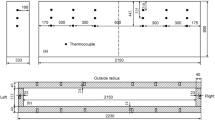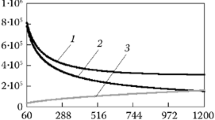Abstract
Thermal boundary conditions applicable to the stationary part of DC casting have been determined using a laboratory set-up and 2D inverse modeling techniques. The influence of (non casting) parameters on the accuracy of the results is clarified, and the influence of casting related parameters, such as casting speed, water flow rate, temperature, surface structure and type of waterfilm generator on the thermal boundary condition has been examined. This investigation shows that the classical description of a heat transfer coefficient or heat flux as a function of surface temperature alone does not accurately describe the thermal boundary condition typical for DC casting. To account for the effect of impingement and re-heating of the surface in the downstream area, the heat flux as a function of the distance from the impingement point should also be considered. The results show that the effect of the casting speed is mainly expressed in the pre-impingement and impingement zone, whereas the effect of cooling water flow rate is principally expressed in the downstream area.
Access this chapter
Tax calculation will be finalised at checkout
Purchases are for personal use only
Preview
Unable to display preview. Download preview PDF.
Similar content being viewed by others
References
M. Rappaz et al., “Application of inverse methods to the estimation of boundary conditions and properties”, Modeling of Casting, Welding and Advanced Solidification Processes (TMS Publ., Warrendale, USA, 1995), 449–457.
D.C. Prasso, J.W. Evans and I.J. Wilson, “Heat transport and solidification in the electromagnetic casting of aluminum alloys: Part II. Development of a mathematical model and comparison with experimental results”, Metallurgical and Materials Transactions B, 26B (1995), 1281–1287.
D.C. Weckman and P. Niessen, “A numerical simulation of the D.C. continuous casting process including nucleate boiling heat transfer”, Metallurgical Transactions B. 13B (1982), 593–602.
J.A. Bakken and T. Bergstrøm, “Heat transfer measurements during D.C. casting of aluminium; Part I: Measurement technique”. Light Metals (1986), 883–889.
E.K. Jensen et al., “Heat transfer measurements during DC casting of aluminium; Part II: Results and verification for extrusion ingots”, Light Metals (1986), 891–896.
J.F. Grandfield, A. Hoadley and S. Instone, “Water cooling in Direct Chill casting: Part I, boiling theory and control”, Light Metals (1997), 691–699.
H. Yu, “A process to reduce DC ingot butt curl and swell”. Light Metals (1980), 613–628.
Author information
Authors and Affiliations
Editor information
Editors and Affiliations
Rights and permissions
Copyright information
© 2016 The Minerals, Metals & Materials Society
About this chapter
Cite this chapter
Opstelten, I.J., Rabenberg, J.M. (2016). Determination of the Thermal Boundary Conditions During Aluminum DC Casting from Experimental Data Using Inverse Modeling. In: Grandfield, J.F., Eskin, D.G. (eds) Essential Readings in Light Metals. Springer, Cham. https://doi.org/10.1007/978-3-319-48228-6_83
Download citation
DOI: https://doi.org/10.1007/978-3-319-48228-6_83
Publisher Name: Springer, Cham
Print ISBN: 978-3-319-48576-8
Online ISBN: 978-3-319-48228-6
eBook Packages: Chemistry and Materials ScienceChemistry and Material Science (R0)




